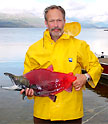Research
The research that my students, post-docs and I conduct is broad in terms of the themes, disciplines, and techniques, but focused in terms of the taxonomic group that we study. Almost all of our work is directed at the family Salmonidae (salmon, trout and charr) but we investigate aspects of their behavior, ecology, evolution, and conservation. This group of fishes is noteworthy for their migrations and homing behavior, and complex population structure that results from the genetic isolation of populations by homing. The genetic differences among populations are balanced by considerable phenotypic plasticity, making these fishes ideal subjects for a range of projects on mechanistic and evolutionary aspects of homing, behavioral ecology, and evolutionary ecology.-In addition, some populations of salmon and trout are in serious decline or have already become extinct, chiefly towards the southern end of their distribution, although others are extremely healthy and support sustainable fisheries. Therefore, the research that we conduct is always placed in the context of the natural and human-related processes affecting salmon and trout, and the importance of linking basic scientific investigations to conservation and management. The specific projects have varied over the years, as the interests of students, the pressing issues, and the funding opportunities have changed.
Currently, the projects are largely divided geographically between those conducted in western Alaska, at the University of Washington’s field camps on the Chignik, Iliamna and Wood River systems, and those conducted in western Washington. As part of a long-term program whose goal is to understand the basic and applied ecology of western Alaska sockeye salmon and their habitats, research is being carried out on the life history patterns, population structure, ecology and behavior of sockeye in a number of streams and lakes in western Alaska. My students and I have been conducting studies of the life history traits, spawning site characteristics, reproductive behavior, energetics, and predator-prey interactions of sockeye salmon. Specific projects have examined: (1) the scale of population structure and homing by sockeye salmon (Quinn et al. 2006; Lin et al. 2008a, 2008b), (2) the relationships between stream entry date, body size, population density, energetics and longevity of adult sockeye salmon in small streams (Hendry et al. 199, 2001; Carlson et al. 2007; Doctor et al. 2009), (3) the influences of habitat, body size, and sex on vulnerability of adult sockeye salmon to predation by bears (Quinn et al. 2001, 2003; Carlson et al. 2009; Cunningham et al. 2013a, 2013b), and (4) the forms of selection exerted by the commercial fishery on the sockeye salmon (Quinn et al. 2007; Kendall and Quinn 2008, 2012, 2013). In addition to these projects on sockeye salmon, we are also investigating the ecology, migrations, and life history of charr in the genus Salvelinus, including Dolly Varden and Arctic charr (Denton et al. 2009, 2010; Woods et al. 2013). See links to the Alaska Salmon Program for more about the field camps and research being conducted there.
In Washington, we are concluding work on the re-colonization of the Cedar River by coho and Chinook salmon after modification of the Landsburg diversion dam in 2003, including the expansion of the salmon populations (Anderson et al. 2010; Anderson et al. 2012). We are beginning a collaborative study of the re-colonization and restoration of the Elwha River after dam removal, with components investigating estuary, river and lake habitats, in collaboration with scientists representing many different agencies and organizations. We are also investigating the migration patterns of different salmonids species in Puget Sound. This work involves a combination of ultrasonic tagging and tracking, and also analysis of coded wire tagging data, in collaboration with NOAA scientists (e.g., Chamberlin et al. 2011a, 2011b). We are comparing the movement patterns of steelhead trout, cutthroat trout (Goetz et al. in press), bull trout, coho salmon (Rohde et al. in press) and Chinook salmon. Finally, we are concluding our long-term study of the genetic interactions between wild and hatchery-produced steelhead trout in Forks Creek, a tributary of the Willapa River in southwestern Washington (Seamons et al. 2012; Naish et al. 2013).
